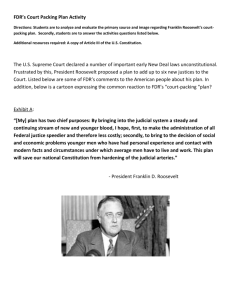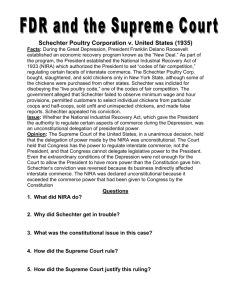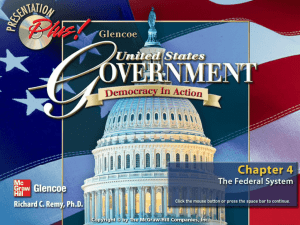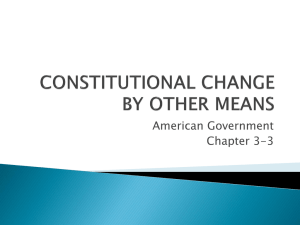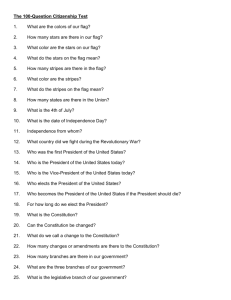Chapter 15 The Supreme Court and the New Deal
advertisement
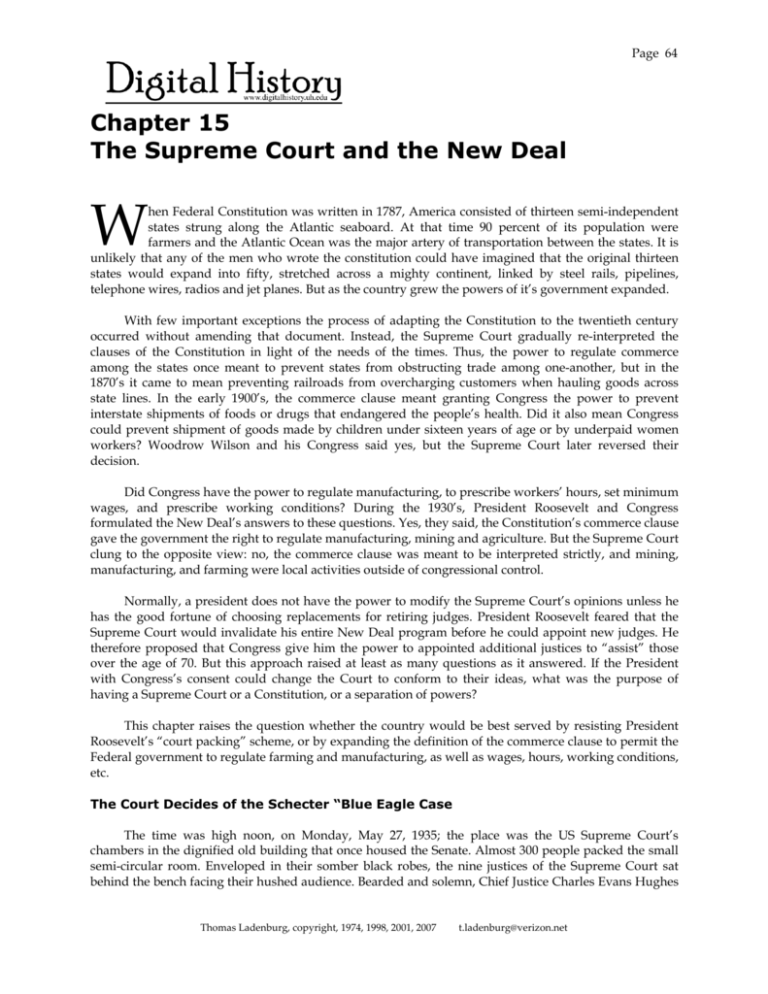
Page 64
Chapter 15
The Supreme Court and the New Deal
W
hen Federal Constitution was written in 1787, America consisted of thirteen semi-independent
states strung along the Atlantic seaboard. At that time 90 percent of its population were
farmers and the Atlantic Ocean was the major artery of transportation between the states. It is
unlikely that any of the men who wrote the constitution could have imagined that the original thirteen
states would expand into fifty, stretched across a mighty continent, linked by steel rails, pipelines,
telephone wires, radios and jet planes. But as the country grew the powers of it’s government expanded.
With few important exceptions the process of adapting the Constitution to the twentieth century
occurred without amending that document. Instead, the Supreme Court gradually re-interpreted the
clauses of the Constitution in light of the needs of the times. Thus, the power to regulate commerce
among the states once meant to prevent states from obstructing trade among one-another, but in the
1870’s it came to mean preventing railroads from overcharging customers when hauling goods across
state lines. In the early 1900’s, the commerce clause meant granting Congress the power to prevent
interstate shipments of foods or drugs that endangered the people’s health. Did it also mean Congress
could prevent shipment of goods made by children under sixteen years of age or by underpaid women
workers? Woodrow Wilson and his Congress said yes, but the Supreme Court later reversed their
decision.
Did Congress have the power to regulate manufacturing, to prescribe workers’ hours, set minimum
wages, and prescribe working conditions? During the 1930’s, President Roosevelt and Congress
formulated the New Deal’s answers to these questions. Yes, they said, the Constitution’s commerce clause
gave the government the right to regulate manufacturing, mining and agriculture. But the Supreme Court
clung to the opposite view: no, the commerce clause was meant to be interpreted strictly, and mining,
manufacturing, and farming were local activities outside of congressional control.
Normally, a president does not have the power to modify the Supreme Court’s opinions unless he
has the good fortune of choosing replacements for retiring judges. President Roosevelt feared that the
Supreme Court would invalidate his entire New Deal program before he could appoint new judges. He
therefore proposed that Congress give him the power to appointed additional justices to “assist” those
over the age of 70. But this approach raised at least as many questions as it answered. If the President
with Congress’s consent could change the Court to conform to their ideas, what was the purpose of
having a Supreme Court or a Constitution, or a separation of powers?
This chapter raises the question whether the country would be best served by resisting President
Roosevelt’s “court packing” scheme, or by expanding the definition of the commerce clause to permit the
Federal government to regulate farming and manufacturing, as well as wages, hours, working conditions,
etc.
The Court Decides of the Schecter “Blue Eagle Case
The time was high noon, on Monday, May 27, 1935; the place was the US Supreme Court’s
chambers in the dignified old building that once housed the Senate. Almost 300 people packed the small
semi-circular room. Enveloped in their somber black robes, the nine justices of the Supreme Court sat
behind the bench facing their hushed audience. Bearded and solemn, Chief Justice Charles Evans Hughes
Thomas Ladenburg, copyright, 1974, 1998, 2001, 2007
t.ladenburg@verizon.net
Page 65
in his high-backed chair was flanked by associate justices, formally arranged on either side of him
according to their years of service with the Court.
All attention was focused on the strong face of the Chief Justice as he read his decision in the case,
Schecter v. the United States. Hughes’ words echoed across the silent room. The Court had decided against
the US government. The Live Poultry Code, embodying regulations issued by the National Recovery
Administration, was unconstitutional.
Although the Schecters bought their chickens outside of New York State, the Court claimed, that
the poultry could not be considered part of interstate commerce because it “was trucked to [the
Schecter’s} slaughterhouses in Brooklyn for local disposition and sale. The interstate transaction in
relationship to that poultry then ended.” Using this logic the Court concluded that the buying and selling
of chickens was a local industry and could not be regulated by the Federal government. Therefore the
Federal code enacted under the auspices of the National Recovery Act was null and void, and the Federal
government could not make laws regulating wages, hours, or working conditions in similarly constituted
businesses.
A Return to “Horse and Buggy Days
Four days later President Roosevelt expressed his disappointment with the Supreme Court’s
decision, claiming that “we have been regulated to the horse and buggy days of interstate commerce” and
wondering whether the decision meant that the United States government has no control over any
national economic problem?
As if to answer the President’s inquiry, early the next year the Supreme Court ruled the
Agricultural Adjustment Act unconstitutional because:
Its stated purpose is the control of agricultural production, a purely local activity, in an effort to
raise the prices paid the farmer. Indeed, …the commerce clause, for the purpose of the present
case, may be put aside as irrelevant….8
The same year the Supreme Court applied the principle in the NRA and the AAA cases to the
Guffey Bituminous Coal Act of 1935 because:
The local character of mining, of manufacturing and of crop growing is a fact, whatever may be
done with the products. 9
The Supreme Court apparently had taken little account of the fact that 97 percent of the coal
produced by the company just ruled out of interstate commerce was sold outside of the state in which it
was mined.
8 Quoted in James Morton Smith and Paul L. Murphy, Liberty and Justice-A Historical Record of
American Constitutional Development (New York: Alfred A. Kropf, 1958), p. 414.
9 Quoted in ibid., p. 416.
Thomas Ladenburg, copyright, 1974, 1998, 2001, 2007
t.ladenburg@verizon.net
Page 66
Criticism of the Court
By rigidly defining interstate commerce to mean only goods actually moving between states, the
Supreme Court claimed to be preserving the rights of states against the powers of the national
government. But in a split decision in 1936, the Court declared a New York State law unconstitutional
which set a minimum wage for women because it interfered with their freedom of contract. Decisions of
this kind had already invalidated a federal minimum wage law, and prompted United Mine Workers
Union President John L. Lewis to proclaim, “it is a sad commentary on our form of government when
every decision of the Supreme Court seems designed to fatten capital and to starve and destroy labor.”
There were others who agreed with Lewis, including a minority in the Court itself. Justice Cardozo,
for instance, believed, “that the Constitution did not condemn Congress “to inactivity in the face of price
wars and wage wars.” Justice Stone in the minimum wage case proclaimed he could find “no basis for the
majority’s decision, other than our own personal economic predilections.” Furthermore, he opined that
“{t]here is grim irony in speaking of the freedom of contract of those who, because of their economic
necessities, give their services for less than is needful to keep body and soul together.”
The President’s “Court Packing Scheme
Believing that ‘the judges have decided that, under the Constitution, the Federal government
cannot lift men, women, and children out of
the degradation of unconscionable hours,
wages, or working conditions “…because it
invades the right of property,” President
Roosevelt delivered a bombshell to Congress
on February 5, 1937. His proposed Judicial
Reorganization bill stressed the need of
adding younger judges — one for each over 70
years of age. He defended his plan as follows:
Since the rise of the modern movement for
social and economic progress through
legislation, the Court has more and more
often and more boldly asserted a power to
veto laws passed by the Congress and
State legislatures. …
In the last four years the sound rule of
giving statutes the benefit of all
reasonable doubt has been cast aside….
We have , therefore, reached the point as a
Nation where we must take action to save
the Constitution from the Court and the
The Supreme Court vs. the New Deal
Court from itself. We must find a way to
take an appeal from the Supreme Court to the Constitution itself. We want a Supreme Court that
will do justice under the Constitution — not over it. In our courts we want a government of laws
and not of men.
Thomas Ladenburg, copyright, 1974, 1998, 2001, 2007
t.ladenburg@verizon.net
Page 67
I want — as all Americans want — an independent judiciary as proposed by the framers of the
Constitution. That means a Supreme Court that will enforce the Constitution as written — that
will refuse to amend the Constitution by the arbitrary exercise of judicial power — amending by
judicial say-so. It does not mean a judiciary so independent that it can deny the existence of facts
universally recognized.10
Opposition to Court Packing
After due consideration the Senate Judiciary Committee emphatically disagreed with President
Roosevelt’s ideas of Court reform. Its report cited the Founding Fathers’ commitment to the idea of
separation of powers, which would be violated if one branch of government, or even two branches, could
irrevocably alter the Constitution to achieve its legislative ends:
Today it may be the Court which is charged with forgetting its constitutional duties. Tomorrow it
may be the Congress. The next day it may be the Executive. If we yield to temptation now to lay
the lash upon the Court, we are only teaching others how to apply it to ourselves and to the people
when the occasion seems to warrant. Manifestly, if we may force the hand of the court to secure
our interpretation of the Constitution, then some succeeding Congress may repeat the process to
secure another and a different interpretation and one which may not sound so pleasant in our ears
as that for which we now contend. …
If this be supported by the toilers of this country upon the ground that they want a Court which
will sustain legislation limiting hours and providing minimum wages, they must remember that
the procedure employed in the bill could be used in another administration to lengthen hours and
to decrease wages. If farmers want agricultural relief and favor this bill upon the ground that it
gives them a Court which will sustain legislation in their favor, they must remember that the
procedure employed might some day be used to deprive them of every vestige of a farm relief.11
Suggested student exercises:
1. What was the basic disagreement over the interpretation of the commerce clause between President
Roosevelt and Congress on one side, and the Supreme Court on the other? Why was this difference in
interpretation so important at that time and to this day?
2. What was President Roosevelt’s remedy for the Court’s views on the commerce clause, and how might
his remedy correct the problem but create others?
3. Take the position of the President or of the Senate Judiciary Committee to argue for or against his
proposal for judicial reorganization.
10 Quoted in Henry Steele Commager, Documents of American History (New York: Appleton Century
Croft, , 1963), pp. 384-85
11 Quoted in Henry Steele, op. cit., p. 389
Thomas Ladenburg, copyright, 1974, 1998, 2001, 2007
t.ladenburg@verizon.net
Page 68
Epilogue: A Switch in Time
Even before Roosevelt delivered his “court packing” message, changes occurred within the
Supreme Court which seemed to decrease the need for reorganization. In a notable decision on the
Wagner Act, written before but delivered after Roosevelt’s request for reorganization, the Court had
already began reversing itself on the limitations of interstate commerce:
Although activities may be intrastate in character when separately considered, if they have such a
close and substantial relation to interstate commerce that their control is essential or appropriate
to protect that commerce from burdens and obstructions, Congress cannot be denied the power to
exercise that control.
The Court’s shift to a broader interpretation of the commerce power was demonstrated again in its
decision upholding the Social Security Act. The Court reversed itself again in upholding a state minimum
wage law very similar to the New York law it found unconstitutional a few months earlier. In May of
1937, Justice Van Devanter announced his retirement from the Court, which gave President Roosevelt the
opportunity to appoint a Supreme Court justice with views more similar to his own. Altogether Roosevelt
was able to appoint six new Supreme Court justices and thus won the battle to redirect the thinking of the
Supreme Court without violating the principle of the separation of powers.
Despite his victories in securing a broader interpretation of the commerce clause, President
Roosevelt paid a heavy price for his attempt to pack the Supreme Court. After the uproar over his court
packing bill, Republicans were able to make substantial gains in Congress, and Roosevelt never again
possessed the majorities that allowed him to pass such liberal legislation as the farm program, minimum
wage, Social Security, or TVA. With war clouds rising over Europe and Asia, the attention of the
President and the country shifted from his program of domestic reform to foreign affairs. Within three
years, Dr. “End-the-Depression” was replaced by “Dr. Win-the-War”. Further debates over domestic
reforms had to be postponed to the post war era, and the clash between liberals and conservatives was
temporarily and partially put aside only to be fully resumed after World War II.
Thomas Ladenburg, copyright, 1974, 1998, 2001, 2007
t.ladenburg@verizon.net
Page 69
End of Unit Essay Question:
Based on your understanding of the material in this unit, decide whether the U.S. should follow
liberal or conservative economic policies. Then write an essay of at least 1,200 words supporting your
answer. Your essay should cover the following topics:
a. On the whole, were conservative policies responsible for the prosperity of the 1920’s or for the
Depression that followed (or for both)? Give evidence (including statistics) to support your claim.
b. On the whole, were the aid programs you studied in Roosevelt’s New Deal unnecessary and
unsuccessful or did they meet the real needs of those they were supposed to help? Give specific examples
of at least three New Deal Programs (and be sure to include the idea of deficit spending).
c. Did the New Deal policies under Roosevelt go too far in the direction of reducing the civil liberties of
Americans and threaten to destroy the system of checks and balances embodied in the US Constitution?
Your essay should include an introduction, a thesis in which you state the major idea you will support, a
paragraph which foreshadows or anticipates your major arguments, a main body incorporating
supportive evidence from this unit, and a conclusion which states what you have proved.
Thomas Ladenburg, copyright, 1974, 1998, 2001, 2007
t.ladenburg@verizon.net
